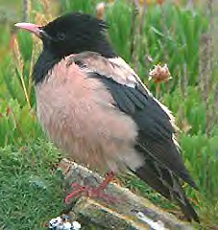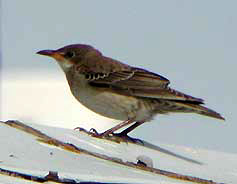Rose-coloured Starling Sturnus roseus
A juvenile on September 1st, 2002, on Eocheong Island, Jeollabuk Province is presumed to be the first record, though an earlier claim (quite possibly based on correct identification) apparently already exists (Park Jin-Young pers com.).
Arriving at the lighthouse area, the only accessible point on Eocheong island in the west/ northwest, at about 1730 of September 1 in moderate westerly winds with bright sunny conditions (the day after the passage of typhoon Rusa), NM noticed the silhouette of a bird, similar in size and shape to a Blue Rock Thrush Monticola solitarius about 50 m distance. Approaching closer, the bird took flight, and called, a Brown-eared Bulbul Hypsipetes amaurotis like "Heek-ik" as it flew across a gully. In flight the bird appeared (1) Common Starling Sturnus vulgaris -shaped and sized and overall brown, with (2) a clearly paler rump and (3) no white in the wings or anywhere else in the upperparts. It landed on the exposed top of a pine, and calling once more, it started to preen. Through 8x42 Leica binoculars the bird’s identification remained unclear, but through a tripod-mounted Nikon telescope, (4) its bill was clearly heavy and orangey-pink based: Rose-coloured Starling, a species NM had last seen in the UK in the 1980s. It could be immediately aged as a juvenile.
Watched through the scope as it preened (and then closed and opened its eyes slowly) for 2-3 minutes, it was noted at the time as being (5) overall plain and generally sandy-buffy brown, (6) darker above than below, with (7) blackish wings (showing very pale, whitish fringes to the flight feathers, but no white patch on e.g. the coverts, further ruling out Red-billed Starling Sturnus sericeus) and (8) an obviously darker tail. The rump at rest appeared slightly paler, less striking than when in flight. (9)The head was dull, with a dark eye, suggesting female or juvenile Chestnut-cheeked Starling Sturnus philippensis. (10) It did not show an obviously contrastingly paler throat like juvenile Common Starling.
The bill was rather shorter and stouter looking than the bill of Common Starling, especially in the region, orangey-pink basally on the lower mandible, and the lower part of the upper, with an obviously darker culmen, and apparently a darker tip. The legs were a weak pink.
The bird flew again across the gully, again giving good flight views confirming the complete absence of any white wing patch and the presence of a paler rump, this time landing in large berry-laden bush. Further brief views were had over the next 15-20 minutes, both as it appeared to feed inside the bush and then as it flew up the hill slope into another large berry tree, shortly before sundown.
It did not show again that evening, and although it was searched for, it could not be found the next day either.
Identification was straightforward, and based on its overall size and structure, its pale rump, contrastingly darker tail and wings (lacking white wing patches) and its diagnostic bare parts coloration.
Largely a southwest Asian species (breeding as far east as Northwest China), the Rose-coloured Starling is known to be highly irruptive, undertaking occasional mass extralimital movements. In 2002, exceptional numbersof the species were recorded in western Europe (e.g. Gantlett 2002), and it is listed in Robson (2000) as a vagrant to Thailand, Singapore and East Viet Nam. Not listed for Japan by Brazil (1991), the species has subsequently been photographed in Japan (in the mid-1990s and again on December 27th 2000 on Miyako, Okinawa, and on Ishigaki on April 6th 2001: Koji Tagi in lit.). Mackinnon and Phillipps (2000) also state that the species has been recorded in both Shanghai and Hong Kong. Chalmers (1986) states that there is one record for Hong Kong, involving two immatures, between 30 December 1984 and March 16th 1985, with a third record, that of a juvenile, at Mai Po, on December 31st 1996 (Paul Leader in lit.).
It would appear likely that this highly irruptive species will prove in the future to be a rare but not exceptional vagrant to Korea, perhaps most likely to occur in the autumn and again in the spring.

Portland Bird Observatory,
Photo © Martin Cade

Portland Bird Observatory,
Photo © Martin Cade



